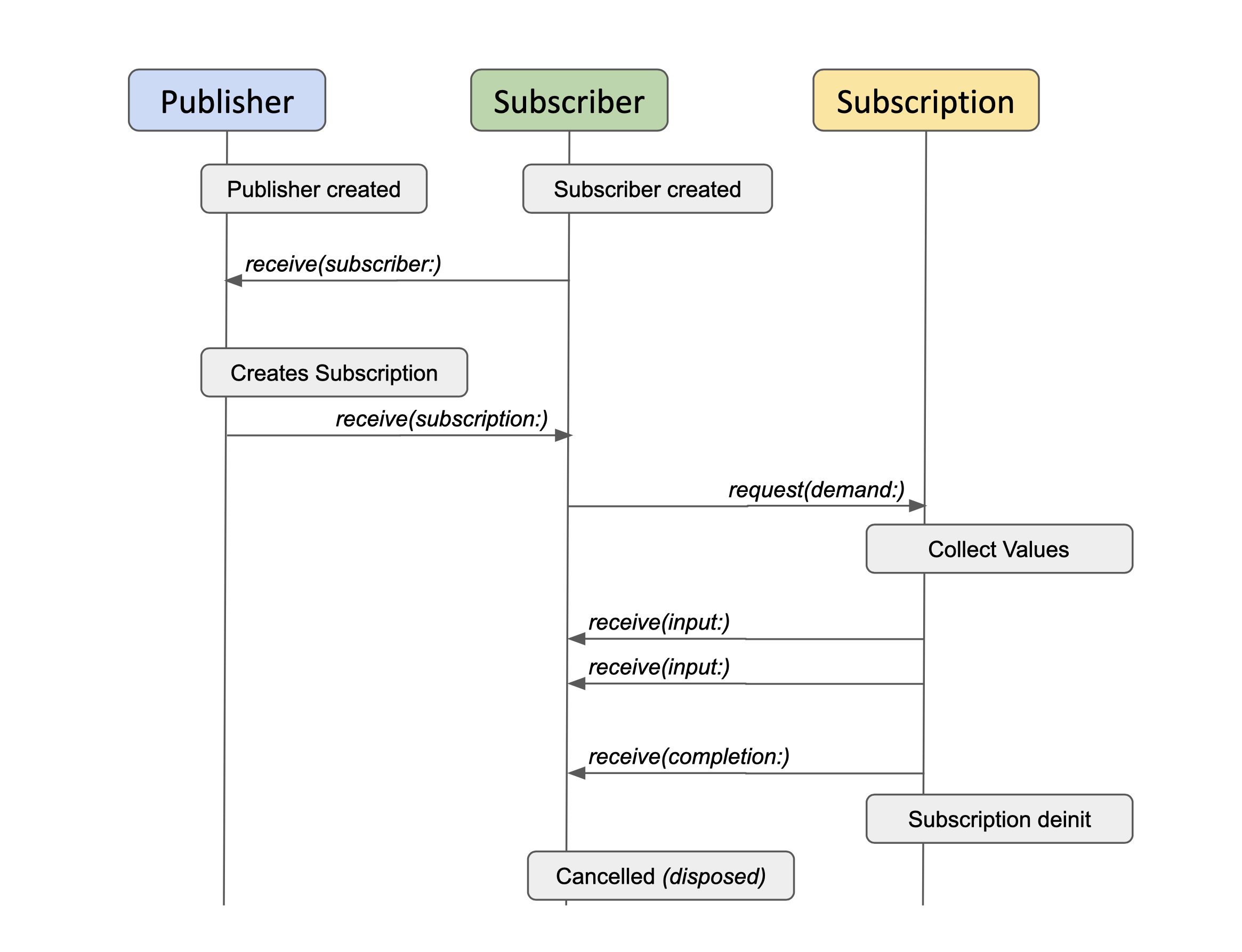Key Points
- Apple introduced a new framework to deal with asynchronous programming called Combine in WWDC 2019.
- A framework which provides stream of events which can emits values and optionally end in a success or error.
- Or It is a declarative Swift API for processing values over time.
- Or It provides a native way of handling asynchronous events.
- The biggest caveat at the moment is that it is only available for iOS 13 and above.
- Combine lacks proper documentations and also does not have anything similar to RxCocoa where we could map our UI elements with Publishers and Subscribers.
Key Concepts
- Publisher
- Subscriber
- Subscription
- Cancellable
Publisher:-
- Publishers are the declarative part of Combine’s API. They describe how values and errors are produced. But they don’t produce, they publishes. we’ll see how.
- Publishers are value types, so they are struct.
- Publishers also allow for registrations of a subscriber. Something which receives values overtime.
- Publishes a stream of values, which becomes accessible only when subscribed to.
1
2
3
4
5
6
protocol Publisher {
associatedtype Output
associatedtype Failure: Error
func subscribe<S: Subscriber>(_ subscriber: S) where S.Input == Output, S.Failure == Failure
}
- It is defined as a protocol with two associated type values Output and Failure. If it is not possible for a publisher to produce an error, then we can use the type Never for the associated type.
- Publisher has one key function called
subscribe()
Built in Publishers
- NotificationCenter
- DataRequest
- Timer and etc
Subscriber:-
- Subscribers are the counterpart to Publishers. They receive values including the completion.
- Usually Subscribers act and mutate state upon receipt of values, and for mutating state we use reference types in Swift. This means that they are Classes.
1
2
3
4
5
6
7
8
protocol Subscriber {
associatedtype Input
associatedtype Failure: Error
func receive(subscription: Subscription)
func receive(_ input: Input) -> Subscribers.Demand
func receive(completion: Subscribers.Completion<Failure>)
}
- It is defines as a protocol with two associated type values Input and Failure.
- Input type must match with its Publisher’s Output.
- It has 3 key functions
- It can receive a subscription
receive(subscription: Subscription) - It can receive an Input
- It can receive completion
Built in Subscriber
- Sink
- Assign and etc
So till now we’ve got the idea about publisher and subscriber. It’s obvious, that we have a publisher — that thing, which gives us values, and a subscriber, which requests this values for its own purpose. But the main part of this collaboration is usually hidden. I’m ? talking about subscription by itself, and that’s where all the magic happens. Subscription is like Interactor, ViewModel or simply Brain of publisher-subscriber collaboration. The publisher creates a subscription with all required dependencies and gives it to the subscriber. After this, the subscription starts acting and processing values over time. Then subscriber consumes these values and we can receive them in the sink closure.
Subscription
- A subscription is how a subscriber controls the flow of data from Publisher to a Subscriber.
1
2
3
4
protocol Subscription: Cancellable {
func request(_ demand: Subscribers.Demand)
}
- It’s a protocol which inherits
Cancellable - It has an only function which requests for the
Demanda struct. Which defines the number of values a subscriber is subscribed to. - There are three types of
Demand.none,.unlimitedand.max(Int) - For example
sinksubscriber function is always subscribe to.unlimitedvalues.
Cancellable
- A confusing one, because there’s not much documentation around it.
- Cancellation is also build into combine.
- Whenever a subscriber no longer needs to receive elements from a publisher, it may cancel its subscription. means set it to
nil. - Cancellation allows your to tear down the sequence of Publisher and subscribers early if we need to.
1
2
3
4
protocol Cancellable {
func cancel()
}
- It’s a protocol, which has a function to cancel the current subscription.
- It is documented that each subscriber should implement cancellable but how and flow are not mentioned. If we do not implement, I’ve not figured how it will affect.
The subscriber types created by sink(receiveCompletion:receiveValue:) and assign(to:on:) both implement the Cancellable protocol, which provides a cancel() method. and they actually return
AnyCancellable.
The Flow/Pattern

Demo Time
- Existing publisher and subscriber
- Custom publisher
- Custom subscriber
Other
- Operators
- Subjects
- Type Erasers
- RxSwift vs Combine etc
Operators
- Operators are Publisher, and they are also declarative and therefore the value types.
- Changing behavior, adding values, removing values or etc
- They subscribe to another publisher (upstream)
- and They send result to subscriber (downstream)
Subjects
- Subjects act both as a Subscriber and a Publisher.
- While a subject can receive values from an upstream publisher, it can also pass along these values to its downstream subscribers.
1
let currentSubject = CurrentValueSubject(1)
A CurrentValueSubject will hold an initial value.
1
let passthroughSubject = PassthroughSubject()
A passthrough subject will start emitting values only when it gets subscribed to.
Type Erasers
- AnySubscriber wraps the Publisher protocol.
- AnyPublisher wraps the Subscriber protocol.
- AnySubject wraps a subject.
- AnyCancellable is a type-erased class that will automatically call
cancel()ondeinitusing Swift’s memory management system.
RxSwift vs. Combine
If we look into the APIs of RxSwift and ReactiveSwift, we could say that Combine is inspired by these framework API set. It is very similar when compared, and now there is a cheatsheet available as well which lists components and operators of Combine and RxSwift frameworks: https://github.com/CombineCommunity/rxswift-to-combine-cheatsheet
In RxSwift..
Publishersare ObservablesSubscribersare ObserversCancellableis Disposable (There’s no DisposeBag)CurrentValueSubjectis BehaviorSubjectPassthroughSubjectis PublishSubjecteraseToAnyPublisheris asObservablehandleEvents()is do()Singleis Future
Thanks for the read, see you in next article :)